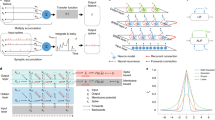Abstract
We present software facilitating the usage of the BrainScaleS-2 analog neuromorphic hardware system as an inference accelerator for artificial neural networks. The hardware is transparently integrated into the PyTorch machine learning framework. In particular, we support vector-matrix multiplications and convolutions; corresponding software-based autograd functionality is provided for hardware-in-the-loop training. The software provides support for automatic partitioning and scheduling of neural networks onto one or multiple chips. We discuss the implementation including optimizations, analyze runtime overhead, measure performance and evaluate the results in terms of the hardware design limitations. As an application of the introduced framework, we present a model that classifies activities of daily living with smartphone sensor data.
P. Spilger and E. Müller—Contributed equally.
Access this chapter
Tax calculation will be finalised at checkout
Purchases are for personal use only
Similar content being viewed by others
References
He, H.: The State of Machine Learning Frameworks in 2019. The Gradient (2019)
Weis, J., et al.: Inference with artificial neural networks on analog neuromorphic hardware. In: Gama, J., et al. (eds.) ITEM 2020/IoT Streams 2020. CCIS, vol. 1325, pp. 201–212. Springer, Cham (2020). https://doi.org/10.1007/978-3-030-66770-2_15
Wunderlich, T., et al.: Demonstrating advantages of neuromorphic computation: a pilot study. Front. Neurosci. 13, 260 (2019). https://doi.org/10.3389/fnins.2019.00260
Schemmel, J., Billaudelle, S., Dauer, P., Weis, J.: Accelerated analog neuromorphic computing. arXiv preprint (2020). arXiv: 2003.11996 [cs.NE]
Paszke, A., et al.: PyTorch: an imperative style, high-performance deep learning library. In: Wallach, H., Larochelle, H., Beygelzimer, A., d’Alché-Buc, F., Fox, E., Garnett, R. (eds.) Advances in Neural Information Processing Systems, vol. 32 (2019)
Müller, E., et al.: The operating system of the neuromorphic BrainScaleS-1 system. arXiv preprint (2020). arXiv: 2003.13749 [cs.NE]
Müller, E., et al.: Extending BrainScaleS OS for BrainScaleS-2. arXiv preprint (2020). arXiv: 2003.13750 [cs.NE]
Schmitt, S., et al.: Classification With deep neural networks on an accelerated analog neuromorphic system. In: Proceedings of the 2017 IEEE International Joint Conference on Neural Networks (2017). https://doi.org/10.1109/IJCNN.2017.7966125
Cramer, B., et al.: Training spiking multi-layer networks with surrogate gradients on an analog neuromorphic substrate. arXiv preprint (2020). arXiv: 2006.07239 [cs.NE]
Anguita, D., Ghio, A., Oneto, L., Parra, X., Reyes-Ortiz, J.L.: A public domain dataset for human activity recognition using smartphones. In: Esann (2013)
Ronao, C.A., Cho, S.-B.: Human activity recognition with smartphone sensors using deep learning neural networks. Expert Syst. Appl. 59, 235–244 (2016)
Le Gallo, M., et al.: Mixed-precision in-memory computing. Nat. Electron. 1(4), 246–253 (2018). https://doi.org/10.1038/s41928-018-0054-8
Author information
Authors and Affiliations
Corresponding author
Editor information
Editors and Affiliations
Rights and permissions
Copyright information
© 2020 Springer Nature Switzerland AG
About this paper
Cite this paper
Spilger, P. et al. (2020). hxtorch: PyTorch for BrainScaleS-2. In: Gama, J., et al. IoT Streams for Data-Driven Predictive Maintenance and IoT, Edge, and Mobile for Embedded Machine Learning. ITEM IoT Streams 2020 2020. Communications in Computer and Information Science, vol 1325. Springer, Cham. https://doi.org/10.1007/978-3-030-66770-2_14
Download citation
DOI: https://doi.org/10.1007/978-3-030-66770-2_14
Published:
Publisher Name: Springer, Cham
Print ISBN: 978-3-030-66769-6
Online ISBN: 978-3-030-66770-2
eBook Packages: Computer ScienceComputer Science (R0)




